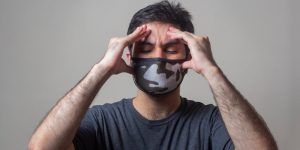What Is Guided Imagery & How Can It Help Your Clients Heal?
 Guided imagery is a therapeutic intervention in the field of complementary and alternative medicine.
Guided imagery is a therapeutic intervention in the field of complementary and alternative medicine.
It can be a powerful technique to use with coaching, counseling, and psychotherapy clients who have difficulties accessing their inner world or articulating their inner experience using only words (Utay & Miller, 2006).
This article will explore the application of guided imagery to specific clinical problems, examine the benefits, and explain how it’s different from meditation.
Before you continue, we thought you might like to download our three Positive CBT Exercises for free. These science-based exercises will provide you with detailed insight into positive Cognitive-Behavioral Therapy (CBT) and give you the tools to apply it in your therapy or coaching.
This Article Contains:
What Is Guided Imagery in Psychology?
Guided imagery is rooted in the practice of multi-sensory visualization, which involves guiding a client on an imaginary journey with their eyes closed following some short breathwork exercises to induce relaxation. It can inspire and induce inner transformation to drive desired behavioral change in areas such as addiction recovery, sports psychology, and stress management (Rossman, 2000).
Not only does this technique refer to the visual aspect of imagination, but all five sensory channels are stimulated to transform the inner world, including thoughts, feelings, and sensations, including the sixth channel of internal self-talk, often through the use of affirmations (Nguyen & Brymer, 2018).
Guided imagery mobilizes your client’s imagination to practice a visualization that addresses a specific psychological need. Most guided imagery will use a combination of breathwork, relaxation, and verbal guidance to stimulate the imagination through a combination of sensory experiences.
Beginning a guided imagery session with relaxation and breathwork helps overcome any resistance to the process by making the client more suggestible. The client remains in complete control during guided imagery practice, as it is not a form of hypnosis – although some hypnotherapists use guided imagery as an intervention (Rossman, 2000).
Guided imagery works because the brain and body respond to imagined experience almost as strongly as if it were really happening (De Paolis et al., 2019). The brain responds to imagined negative outcomes by flooding us with anxiety, which is uncomfortable and can make the imagined threat feel real. However, that same imagination can also be used during guided imagery practice to produce positive effects (Felix et al., 2018).
For example, guided imagery can be used to relax during periods of stress, regulate emotions, help control pain, and even as an adjunctive intervention during cancer treatment to enhance the healing process (De Paolis et al., 2019).
As an intervention, guided imagery is often used to enhance distress tolerance skills during Dialectical Behavior Therapy (DBTSelfHelp.com, n.d.).
A therapist can teach sensitive clients guided imagery techniques to help rewire the brain by activating otherwise dormant neurological pathways through all the six mental channels (the five sensory channels and the inner voice). Used repeatedly, guided imagery can help overcome old triggers that cause reactivity and overwhelm.
Somatic Imagery™ is another guided imagery intervention that uses multi-sensory image making to access a client’s inner experiences and resources that may not be available through talking therapy alone.
Research has shown that traumatic experiences overwhelm the nervous system and are often encoded at a visceral, embodied level rather than as stories that can be accessed through left-brain activities, such as language analysis and verbalization (Drobis & Margolies, 2009). Somatic Imagery™ is a guided imagery intervention used to access right-brain processes that are nonverbal or preverbal.
“Free of the constraints of linear logic and assumptions, Somatic Imagery™ is highly intuitive, creative, less censored and more open to suggestion” (Drobis & Margolies, 2009, para. 6).
In short, guided imagery can provide greater access to preverbal affect and thereby deepen the therapeutic process. Guided imagery can be used to overcome sympathetic nervous system over-arousal by triggering the parasympathetic nervous system into soothing the mind and body. It can be a powerful self-soothing method and aid in emotional self-regulation.
3 Real-Life Examples of Visualization

Visualization in pain management
Given that guided imagery is a popular relaxation technique that eases stress by stimulating the parasympathetic nervous system, it should come as no surprise that visualization is also an adjunctive intervention used in chronic pain management. Chronic pain causes stress, so it makes sense that stress management techniques may impact pain (Carpenter et al., 2017).
One very specific visualization technique is graded motor imagery (GMI), which is used by those with reduced mobility because of chronic pain to visualize moving around pain free (Decety, 1996). All pain comes from the brain, and our brains are neuroplastic, so the more pain we experience, the more those pain signaling nerve pathways are activated by default, leading to a greater sensitivity to pain over time.
However, because of neuroplasticity, the brain can be retrained through GMI to carve out new neural pathways where movement becomes increasingly experienced as pain free through the practice of visualization. The video below by the Neuro Orthopedic Institute explains how GMI works.
Visualization in sports psychology
Another “off the couch” application of visualization is in sports psychology. Elite athletes especially rely on the power of guided imagery and visualization to train their brains to expect their best performance before competing (Decety, 1996).
The intention is to condition the brain to achieve successful outcomes. When a game strategy or athletic performance is mentally rehearsed before actually competing, it may help to reduce pre-competition anxiety due to the inner sense of familiarity with the experience.
Take a look at the short video below for an explanation of the science of visualization for athletes, including fascinating real-life examples of how it all works for boxer Conor McGregor, Olympic swimmer Michael Phelps, and world-famous free climber Alex Honnold.
In short, athletes who train using visualization in addition to more conventional techniques find it gives them the slight edge that is often the difference between winning and losing in elite sports.
Visualizing success in business
Carrie Green, founder of the Female Entrepreneur Association, coaches women in business about how to achieve their goals. She rightly defines successful entrepreneurs as visionaries because all businesses begin as mere ideas that are then translated into reality through action and vision.
As Green says, if entrepreneurs do not have a vision of where they want to be, they will not know how to get there and are likely to become diverted and, as a result, fail.
Vision is essential for achieving business goals, and just like in sports psychology, visualizing success can keep an entrepreneur on track and motivated (Decety, 1996; Vasquez & Buehler, 2007).
In the video below, Green describes how she set the intentions for her successful business far before anything actually happened and positively visualized it happening every single day in detail, using all her five senses. Step by step, as she reached her goals, her vision expanded until she became the bestselling author and coach that she is today.
At the end of the video, she offers a free three-step visualization worksheet.
In short, visualization can help to retrain the brain to take aim and move the client’s life in their desired direction.
How Can Guided Imagery Help Clients?
Guided imagery helps clients by inviting them to use their imagination to stimulate all their senses and their parasympathetic nervous system, which is the part of the nervous system involved in inner regulation and rest (Rossman, 2000). Notice how all the senses are involved in guided imagery, not just a visual simulation. This is required to trick the brain into responding as if the experience were real.
Guided imagery for anxiety
Take a look at this guided imagery journey through a lavender meadow to help overcome stress and anxiety. The smell of lavender has been proven to help regulate the heart, lower blood pressure, and promote relaxation (Koulivand et al., 2013). All the senses are mobilized during this inner journey through the meadow to calm and soothe the fight–flight–freeze response.
Guided imagery for sleep problems
Guided imagery used in conjunction with structured relaxation techniques is a powerful aid to overcoming sleeping problems (Neuendorf et al., 2015).
The 30-minute guided imagery and visualization in the video below is designed to be played while in bed to help encourage sleep. Please don’t play this while driving or doing anything else that requires wakefulness and concentration.
Treating grief with guided imagery
Losing a loved one is always painful, and the grieving process usually differs in relation to the amount of unfinished business the bereaved has with the deceased (Rubel, n.d.). If we lose somebody without having said certain things we wanted to say or resolved disputes, then complicated grief can linger and block the usual grieving process.
In these types of situations, using guided imagery to have an imaginary conversation with the deceased can be cathartic and help release blocked emotions. However, this should not be attempted outside of a therapeutic setting, such as counseling or psychotherapy, because it can trigger unexpected responses and painful emotions (Rubel, n.d.).
Clinical psychologist Dr. John Jordan (2012) offers this free resource on using guided imaginary conversations with the deceased for use in a clinical setting and may prove especially helpful for clients with complicated grief.
A look at guided imagery for kids
Clinical psychologist Dr. Clare Roberts (2019) describes how she stumbled on the power of guided imagery as a mother to her young toddler during what she describes as “the wrestling match at bedtime.”
She included relaxation prompts in the guided-imagery-style bedtime stories she made up for her son and found he would easily fall into a restful sleep. For ideas, look at the Kids Relaxation website for guided imagery stories that can help children relax.
Johns Hopkins Children’s Center has produced a series of guided imagery video resources that are freely available online. These are used as an adjunctive treatment for children staying at the hospital or undergoing long-term treatment for serious conditions like cancer. The guided imagery video below is aimed at 6–12-year-olds to help them relax.
5 Benefits According to Research
Guided imagery:
- Relieves stress, anxiety, and depression (Beizaee et al., 2018; Vagnoli et al., 2019; Weßlau & Stel, 2014)
- Can be used to support pain management (Carpenter et al., 2017; De Paolis et al., 2019; D’arcy-Sharpe, 2020; Ilacqua, 1994)
- Is used to improve mobility in people who experience chronic pain and impaired mobility (Decety, 1996; Patricolo et al., 2017)
- Enhances healing during cancer treatment (Mahdizadeh et al., (2019)
- Is used to enhance focus and achieve goals in sports and business (Ahsen, 2001)
Brief History of Guided Imagery

Worldwide, many ancient cultures had animistic religious traditions that included shamanic journeying, a form of guided imagery that involves meeting spirit guides and ancestors to call on their wisdom and healing power (Kovach, 1985).
Meanwhile, ancient Indian Tantra and Tibetan Buddhism both use guided imagery, including mandala and deity visualization, to promote spiritual development. In Tibetan medicine, guided imagery that includes visualizing a healing deity is a technique used to promote wellbeing and health (Pagliaro & Bernardini, 2019).
In traditional Chinese medicine, blockages in the circulation of chi or qi are believed to cause all forms of illness, both mental and physical. Visualizing the free movement of qi throughout the body is still used to enhance healing (Kemp, 2004).
According to Dr. Martin Rossman (2000), who cofounded the Academy of Guided Imagery in 1989, the ancient Greeks used guided imagery for healing purposes and viewed the imagination as an organ. Rossman’s academy now trains practitioners to use guided imagery in the treatment of chronic pain, cancer, and other conditions.
Currently, guided imagery is regarded as a complementary therapy as a component of other therapeutic interventions. For example, psychodrama is sometimes called guided affective imagery and uses guided imagery in conjunction with role-play to express psychological material kinesthetically (Karp et al., 2005).
Meanwhile, the Bonny Method of Guided Imagery and Music uses guided imagery with music therapy to access elements of a client’s inner world that may not be accessible to traditional talking therapies alone. This is similar to the techniques of shamanic journeying that use the drum, chanting, and guided imagery (Kovach, 1985).
Guided Imagery vs Meditation
Guided imagery involves all our senses and working with our inner voice to create an alternative reality, whereas meditation involves focusing on a specific activity, such as the focus on the breath, movement, or sensing in mindfulness-based stress reduction, or meditations that focus on affect such as loving-kindness or self-compassion meditations.
These practices enhance our awareness of the object of focus and sharpen observation and concentration by excluding distractions.
Most meditation involves concentration or one-pointedness, while guided imagery involves imagining entirely different realities using all of our senses (Rossman, 2000).
Some types of advanced meditation involve a process of witnessing or observation in a state of choice-less awareness. However, during such practices, our awareness is of the ever-changing here and now as it is, free of attachment, and does not involve the imagination in any way (Bedford, 2012).
Despite these differences, an online search for “guided imagery” offers numerous guided meditation resources, as search engines do not seem to appreciate the difference. Some guided meditations include guided imagery, but most guided meditations do not mobilize the imagination using all of our senses.
Resources From PositivePsychology.com
We have numerous free resources to support your exploration of guided imagery as an intervention in your coaching, counseling, or psychotherapy practice.
If you’d like to try one of our guided imagery resources for yourself, download our free 3 Positive CBT Exercises Pack and look at the Solution-Focused Guided Imagery exercise.
Additionally, try this Emotional Footprint worksheet that uses visualization to aid emotional regulation or consider the Visualizing Future Events to Build Authenticity worksheet. This exercise uses imagery to help clients become the person they’d like to be in their relationships with others.
In addition, we have many more resources available in our Positive Psychology Toolkit©.
For example, the Visualizing the Bodily Experience of Emotion tool explains how to use imagery to enhance self-awareness by inviting clients to explore and draw their emotions in the body. Our Motivational Vision Board tool enhances motivation by helping clients connect to the benefits of goal accomplishment by creating a motivational vision board.
If you’re looking for more science-based ways to help others through CBT, check out this collection of 17 validated positive CBT tools for practitioners. Use them to help others overcome unhelpful thoughts and feelings and develop more positive behaviors.
A Take-Home Message
Guided imagery is a very powerful holistic therapy intervention in a range of health conditions. It works by mobilizing the neuroplasticity of the brain to carve out new neural pathways to overcome old neurological ruts that can lead us to experience an entrenched reactivity to many forms of mind and body suffering, including pain, life challenges, sudden change, and loss.
All these experiences are an inevitable part of being human. Having guided imagery techniques in your toolkit can definitely help support you and your clients through the inevitable ups and downs of life, as well as trauma and the recovery from or management of illness.
We hope you enjoyed reading this article. For more information, don’t forget to download our three Positive CBT Exercises for free.
- Ahsen, A. (2001). Imagery in sports, general performance and executive excellence. Journal of Mental Imagery, 25(3–4), 1–46.
- Bedford, F. L. (2012). A perception theory in mind–body medicine: Guided imagery and mindful meditation as cross-modal adaptation. Psychonomic Bulletin and Review, 19, 24–45.
- Beizaee, Y., Rejeh, N., Heravi-Karimooi, M., Davood Tadrisi, S., Griffiths, P., & Vaismoradi, M. (2018). The effect of guided imagery on anxiety, depression and vital signs in patients on hemodialysis. Complementary Therapies in Clinical Practice, 33, 184–190.
- Carpenter, J. J., Hines, S. H., & Lan, V. M. (2017). Guided imagery for pain management in postoperative orthopedic patients: An integrative literature review. Journal of Holistic Nursing, 35(4), 342–351.
- D’arcy-Sharpe, A. (2020). Visualization & guided imagery for pain relief. Pathways Health. Retrieved March 20, 2022, from https://www.pathways.health/visualization-guided-imagery-for-pain-relief/
- DBTSelfHelp.com (n.d.). Distress tolerance: Improve the moment. Retrieved March 21, 2022, from https://dbtselfhelp.com/dbt-skills-list/distress-tolerance/improve/
- Decety, J. (1996). The neurophysiological basis of motor imagery. Behavioural Brain Research, 77(1–2), 45–52.
- De Paolis, G., Naccarato, A., Cibelli, F., D’Alete, A., Mastroianni, C., Surdo, L., Casale, G., & Magnani, C. (2019). The effectiveness of progressive muscle relaxation and interactive guided imagery as a pain-reducing intervention in advanced cancer patients: A multicentre randomised controlled non-pharmacological trial. Complementary Therapies in Clinical Practice, 34, 280–287.
- Drobis, S. & Margolies, C. (2009). What is Somatic Imagery? ImagiNews, The Journal of Imagery International. Retrieved March 21, 2022, from https://centerforhealingandimagery.com/articles/what-is-somatic-imagery/
- Felix, M. M. D. S., Ferreira, M. B. G., Oliveira, L. F., Barichello, E., Pires. P. D. S., & Barbosa, M. H. (2018). Guided imagery relaxation therapy on preoperative anxiety: A randomized clinical trial. Review of Latin American Nursing. 26, e3101.
- Ilacqua, G. E. (1994). Migraine headaches: Coping efficacy of guided imagery training. Headache: The Journal of Head and Face Pain, 34(2), 99–102.
- Jordan, J. R. (2012). Guided imaginal conversations with the deceased. In Techniques of grief therapy. Routledge.
- Karp, M., Holmes, P., & Tauvon, K. B. (Eds.). (2005). The handbook of psychodrama. Taylor & Francis.
- Kemp, C. A. (2004). Qigong as a therapeutic intervention with older adults. Journal of Holistic Nursing, 22(4). 351–373.
- Koulivand, P. H., Khaleghi Ghadiri, M., & Gorji, A. (2013). Lavender and the nervous system. Evidence-Based Complementary and Alternative Medicine, 681304.
- Kovach, A. M. S. (1985). Shamanism and guided imagery and music: A comparison. Journal of Music Therapy, 22(3), 154–165.
- Mahdizadeh, M. J., Tirgari, B., Abadi, O. S. R. R., & Bahaadinbeigy, K. (2019). Guided imagery: Reducing anxiety, depression, and selected side effects associated with chemotherapy. Clinical Journal of Oncology Nursing, 23(5), E87–E92.
- Neuendorf, R., Wahbeh, H., Chamine, I., Yu, J., Hutchison, K., & Oken, B. S. (2015). The effects of mind-body interventions on sleep quality: A systematic review. Evidence-Based Complementary and Alternative Medicine, 902708.
- Nguyen, J., & Brymer, E. (2018). Nature-based guided imagery as an intervention for state anxiety. Frontiers in Psychology, 2(9), 1858.
- Pagliaro, G., & Bernardini, F. (2019). A specific type of Tibetan medicine meditation for women with breast cancer: A pilot survey. Oncology, 97(2),119–124.
- Patricolo, G. E., LaVoie, A., Slavin, B., Richards, N. L., Jagow, D., & Armstrong, K. (2017). Beneficial effects of guided imagery or clinical massage on the status of patients in a progressive care unit. Critical Care Nurse, 37(1), 62–69.
- Roberts, C. (2019, January 14). What is guided imagery? The ultimate guide. Calm Chronicles. Retrieved March 21, 2022, from https://www.generationcalm.com/blog/what-is-guided-imagery-the-ultimate-guide/
- Rossman, M. (2000). Guided imagery for self-healing: An essential resource. H. J. Kramer.
- Rubel, B. (n.d.). Guided imagery when there’s unfinished business. Griefwork Center. Retrieved Match, 21, 2022, from https://www.griefworkcenter.com/guided-imagery-when-theres-unfinished-business/
- Utay, J., & Miller, M. (2006). Guided imagery as an effective therapeutic technique: A brief review of its history and efficacy research. Journal of Instructional Psychology, 33(1), 40–43.
- Vagnoli, L., Bettini, A., Amore, E., De Masi, S., & Messeri, A. (2019). Relaxation-guided imagery reduces perioperative anxiety and pain in children: A randomized study. European Journal of Pediatrics, 178(3), 913–921.
- Vasquez, N. A., & Buehler, R. (2007). Seeing future success: Does imagery perspective influence achievement motivation? Personality and Social Psychology Bulletin, 33(10), 1392–1405.
- Weßlau, C., & Stel, R. (2014). Visual mental imagery in psychopathology: Implications for the maintenance and treatment of depression. Clinical Psychology Review, 34(4), 273–281.
Read other articles by their category
- Body & Brain (49)
- Coaching & Application (57)
- Compassion (26)
- Counseling (51)
- Emotional Intelligence (24)
- Gratitude (18)
- Grief & Bereavement (21)
- Happiness & SWB (40)
- Meaning & Values (26)
- Meditation (20)
- Mindfulness (45)
- Motivation & Goals (45)
- Optimism & Mindset (34)
- Positive CBT (28)
- Positive Communication (20)
- Positive Education (47)
- Positive Emotions (32)
- Positive Leadership (18)
- Positive Parenting (4)
- Positive Psychology (33)
- Positive Workplace (37)
- Productivity (16)
- Relationships (46)
- Resilience & Coping (36)
- Self Awareness (21)
- Self Esteem (38)
- Strengths & Virtues (31)
- Stress & Burnout Prevention (34)
- Theory & Books (46)
- Therapy Exercises (37)
- Types of Therapy (64)





